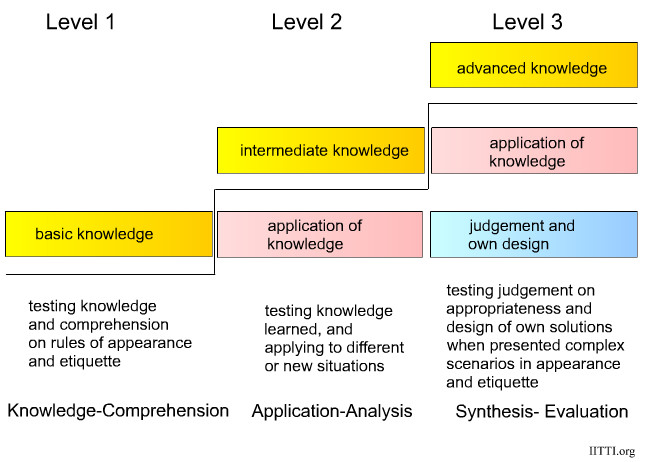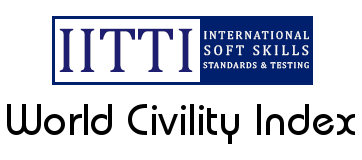|
|
|
Dec 23, 2011 General discussions about Learning Outcomes
General discussions between Christina, Lynne, Kimberly, Riet, Deborah,
Patrick about the first draft of the 'Learning Outcomes' document.
"Western Etiquette" - For Level 1,
we could focus on North American (Canada/U.S.) unless specifically indicated to be European.
For Level 2 and above,
we could go more into the finer details of European etiquette and other major economies' image guidelines.
Terms open to interpretation, such as 'angular shapes', 'smart',
and 'relaxed' will definitely need to be treated with care when translated.
This is where our model of 'open-source'
might help by encouraging and recruiting local native image consultants to contribute to the translation.
Keeping Level 1 simple - Are there too much that we are trying to cover in Level 1?
Very good question!
I specifically wrote a little bit more-than-expected amount of details in the first draft, with good reasons.
(1) This is an attempt to cater to the many Asian markets' characteristics (at least in Japan and China)
where customers frequently demand more-than-necessary details,
unlike many of us in "the west" where we have a minimalist mentality.
(Just look at some Chinese websites and you can soon see what I mean: each page is jam-packed with words!
They don't seem to have preference for white space where the eyes and the mind can take a rest.)
(2) If Level 1 is kept to a very basic, bare-bone guideline,
would it be difficult for image schools to market it profitably?
That is, can schools build a program with substantial bulk to make it worthwhile?
It might be beneficial at this stage to think about the end product that schools can design and market around in a commercially viable way,
and then we can work backward to decide how big our Level 1 should be.
I invite you to pass judgment since you have so much real-world business experience:
if Level 1 is going to be say a 3-5 hours course,
image schools may not be able to command a healthy tuition fee (and profit margin),
and Level 1 would have few followers. In addition, some prospective students may also view it as too "mickey mousy",
and won't take Level 1 seriously. Whereas, at the other extreme,
if Level 1 is like a full-semester university course of 45 hours,
cost would be high, and it may fail just as if it were too skimpy.
The "sweet spot" would be not too skinny and not too bulky.
(I had very little "feel" for the sweet spot at the beginning of designing the levels half a year back,
but after consulting with Kimberly, we felt that a 15-hour course might be a best-guess guideline.
A 15-hour course could be delivered in a 2-day program.)
What do you think about the 15-hour goalpost?
How about this? I will add many of the new items as suggested to the first draft,
and then we can all go through it to decide what should be in Level 1 and what we should move to Level 2.
Will this work?
Gestures, first arrival in a country - In the first draft,
the direction was to target in-country business people in interacting with western business associates going to their country
(e.g. Chinese business people receiving Americans going to China), not so much about traveling abroad to a western country.
I think we need to work hard on this one: what do we define as the typical subscriber to Level 1?
If we are going to market Level 1 as something "relevant for the majority of the population",
should we push gestures or first arrival to Level 2?
As these would not be needed as much for in-country people as outbound people?
Or are these topics really should be looked at as 'basic',
something that is in line with Level 1's essence of 'keeping up'?
The discussion of whether gestures and first-arrival scenarios should be listed under Level 1 or 2 leads us to a more important question that we should ask and be able to articulate in VERY precise terms:
Who really are our targets?
A proposed target audience
(under Meeting notes Oct 21, 2011 Discussion with Kimberly about overall exam structure)
is pasted here for further discussion:
Marketing targets
Level 1, 2
- university students
- colleges, language schools, senior high schools (Grade 11, 12)
- multi-nationals
- tourism
- service industries (hotels, restaurants, spas)
Level 3
- people already in the work force
- middle-management, government officials
The above list was an attempt in very general terms. We may want to have a finer profiling.
I will take the liberty to make the first try:
Level 1 Profiling:
|
Name:
|
David Wang
|
|
Location:
|
Shanghai, China
|
|
Age:
|
24
|
|
Education:
|
Bachelor of Business Administration,
Fudan University (a top university in China, something like Princeton in the U.S.)
|
|
Job:
|
Hotel assistant beverage manager at the Shanghai Hyatt, first job, 2 years experience since graduation
|
|
Travel:
|
No business travel needed. No personal travel outside of country because of cost.
|
|
Background:
|
Family are all in Shanghai.
Father is in his early 50's working as an editor for a fashion magazine.
He also graduated from Fudan University in the early '80s.
Mother is in her late 40's working for an import/export trading company.
She graduated from a vocational college in the early '80s.
David lives in a 600 sq-ft apartment together with his parents.
|
Level 2 Profiling:
(Same David Wang, at age 32,
after successfully obtained the IITTI Level 1 Certification, eight years later)
|
Jobs since then:
|
Promoted to hotel beverage manager at Hyatt two years since Level 1.
Transferred to marketing and sales as assistant manager three years since last position.
Promoted to senior assistant marketing and sales manager last year.
|
|
Travel:
|
Some business travel for hotel management training. Some personal travel outside of country.
|
|
Personal life:
|
Met Wendy Wu who works at the same hotel as a front desk clerk.
Married two years ago. No kids.
Bought a small 500 sq-ft apartment.
|
Level 3 Profiling:
(Same David Wang, at age 35,
after successfully obtained the IITTI Level 2 Certification, three years later)
|
Jobs since then:
|
Promoted to sales manager at Hyatt two years since Level 2.
|
|
Travel:
|
Extensive business travel for hotel leadership as a coach. Some personal travel outside of country.
|
|
Personal life:
|
One baby girl, 1 year old.
|
Follow a proven taxonomy
Knowledge-Comprehension-Application-Analysis-Synthesis-Evaluation
These add depth to the whole concept!
I have attached a diagram to indicate what we can do in using this model for depth while still be able to add new materials in Level 2 and beyond.

|
|



